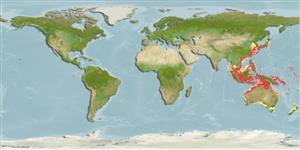Environment: milieu / climate zone / depth range / distribution range
Ecologia
marino associati a barriera corallina; distribuzione batimetrica ? - 100 m (Ref. 90102). Tropical
Indo-West Pacific: India east to Indochina, then north to Japan and China to the Philippines, Indonesia and Australia.
Size / Peso / Age
Maturity: Lm ? range ? - ? cm
Max length : 29.5 cm TL maschio/sesso non determinato; (Ref. 126280); peso massimo pubblicato: 453.00 g (Ref. 126280)
Spine dorsali (totale): 4 - 5; Raggi dorsali molli (totale): 13-14; Spine anali 13. Indonesian form has pale body with dark blotches (Ref. 48636). Body dark brown with 3 distinct broad black bands. Respiratory valve inside lower jaw with a thick orange tentacle (Ref 42788).
Found above 100 m on sandy gravel bottom (Ref. 11230). Lives on muddy substrates and rarely observed (Ref. 48636). Hides in sandy bottoms and sucks up animals with sand and debris into the mouth.
Life cycle and mating behavior
Maturità | Riproduzione | Deposizione | Uova | Fecundity | Larve
Masuda, H., K. Amaoka, C. Araga, T. Uyeno and T. Yoshino, 1984. The fishes of the Japanese Archipelago. Vol. 1. Tokai University Press, Tokyo, Japan. 437 p. (text). (Ref. 559)
IUCN Red List Status (Ref. 130435)
Threat to humans
Harmless
Human uses
Pesca: scarso interesse commerciale; Acquario: Commerciale
Informazioni ulteriori
Nomi ComuniSinonimiMetabolismoPredatoriEcotossicologiaRiproduzioneMaturitàDeposizioneSpawning aggregationFecundityUovaEgg development
BibliografiaAcquacolturaProfilo di acquacolturaVarietàGeneticaElectrophoresesEreditarietàMalattieElaborazioneNutrientsMass conversion
CollaboratoriImmaginiStamps, Coins Misc.SuoniCiguateraVelocitàModalità di nuotoArea branchialeOtolithsCervelliVista
Strumenti
Special reports
Download XML
Fonti Internet
Estimates based on models
Preferred temperature (Ref.
123201): 22.9 - 29, mean 28 °C (based on 1308 cells).
Phylogenetic diversity index (Ref.
82804): PD
50 = 0.5000 [Uniqueness, from 0.5 = low to 2.0 = high].
Bayesian length-weight: a=0.01072 (0.00554 - 0.02071), b=3.09 (2.92 - 3.26), in cm total length, based on LWR estimates for this species & Genus-body shape (Ref.
93245).
Trophic level (Ref.
69278): 4.1 ±0.7 se; based on size and trophs of closest relatives
Resilienza (Ref.
120179): Medio, tempo minimo di raddoppiamento della popolazione 1.4 - 4.4 anni (Preliminary K or Fecundity.).
Fishing Vulnerability (Ref.
59153): Low vulnerability (20 of 100).
